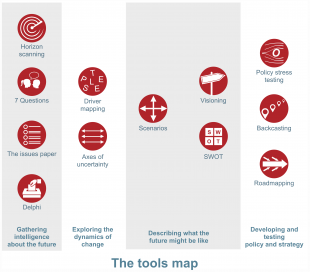Alister Wilson consults in futures and strategic planning with clients in government, the wider public sector and the private sector. He collaborated with the Government Office for Science to produce The Futures Toolkit.
There is a lot happening in the world at the moment. Artificial Intelligence and robotics are poised to transform the world of work and connectivity and communications are changing the nature of the economy and how we interact. The places we live are changing, with megacities becoming more, well, mega. The potential effects of these changes are also difficult to identify. With two thirds of the world’s adult population connected to the internet, the opportunities (and threats) of online communities and activities are hard to keep track of, let alone regulate. And don’t forget blockchain.
One thing seems certain - that disruption and change are pervasive. Even, perhaps, the new normal.
Uncertainty is normal, too
Disruption creates uncertainty for strategists and policy makers who want to understand the future development of their policy area. How do they know what’s important? What’s unimportant? What are the emerging trends shaping the future and how might they combine to disrupt markets? What might the new opportunities and threats be? How can policy anticipate what markets and actors will need in the future and how can it stimulate change? And, perhaps critically, what are the changes that lie outside the control of government, businesses and individuals that we need to prepare for?
The Futures Toolkit
These are some of the questions that the Government Office for Science’s Futures Toolkit sets out to help answer. The Toolkit is a resource that sets out a range of tools that can be used to explore and make sense of future uncertainty (see The tools map). There are 12 tools organised according to their primary purpose – gathering intelligence about the future, exploring the dynamics of change, describing what the future might be like and developing and testing policy and strategy. Each procedure is set out in detail, along with notes and guidance on design and facilitation. Annexes provide examples of the outputs that different tools generate.
The tools are adaptable and can be customised to meet the needs of most futures projects. The Toolkit sets out a number of pathways - different ways the tools can be combined to meet specific business needs – that are designed to help users get started. Users can also create custom pathways to meet their specific needs. This flexibility is an important aspect of the Toolkit’s design.
It’s practical, too. Those new to the field will an introduction to tools that are in common and frequent use in the futures community and experienced futures practitioners will find much that is familiar (along with plenty of new insights, of course!). There are case studies from across government and its agencies, sample horizon scans and futures interviews, illustrative scenarios and visions and thoughts on how to introduce metrics into futures work without creating hostages to fortune.

Connecting futures to policy
Ultimately, of course, the connection between futures and policy cannot be taken for granted. The toolkit is designed to help those involved in the project, whether they are futures practitioners, project owners or key stakeholders, recognise and work together to address this in the project design process. Thinking about the future using the tools in the Toolkit helps create a bridge between understanding current events and formulating policy (see Futures in the policy cycle). Here, like many strategy processes, the solution is based on understanding stakeholder need and managing relationships and expectations to create the optimal outcome. Getting this right means that the ideas and insights emerging from futures work can feed directly into policy development.

3, 2, 1, Go
And it really isn’t difficult. One of my favourite quotes about futures is something that Peter Schwartz - former head of scenario planning at Shell, co-founder of the Global Business Network, author of The Art of the Long View and now Senior VP Strategic Planning at Salesforce – once said:
‘Scenario planning isn’t rocket science. Believe me. I used to be a rocket scientist.’